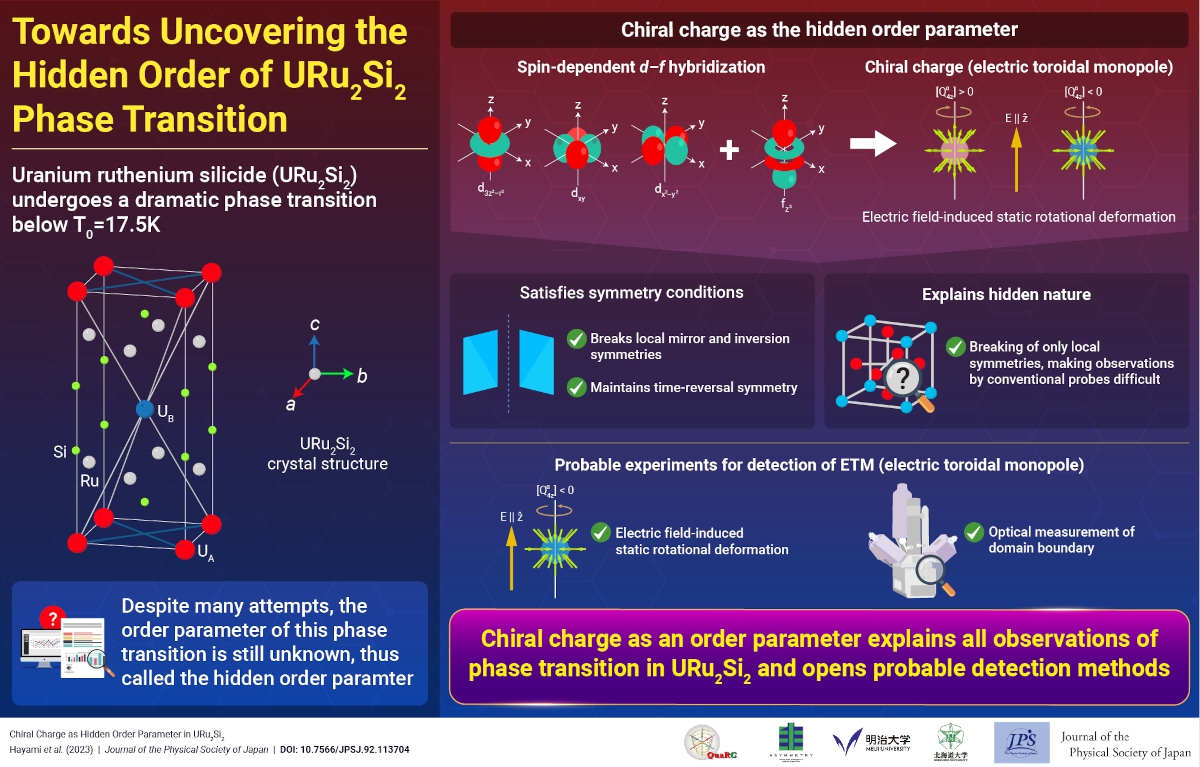Towards Uncovering the Hidden Order of URu2Si2 Phase Transition
© The Physical Society of Japan
This article is on
Chiral Charge as Hidden Order Parameter in URu2Si2
(JPSJ Editors' Choice)
J. Phys. Soc. Jpn. 92, 113704 (2023).
We propose a chiral charge as the hidden order parameter in URu2Si2 and present experiments to detect it by focusing on breakings of mirror and inversion symmetries at the local uranium ion.

In condensed matter physics, various types of phase transitions have been observed and their nature has been clarified by intensive experimental and theoretical studies. However, the order parameter of the phase below critical temperature T0 = 17.5 K in URu2Si2 has still been uncovered since its discovery in 1985 despite many efforts by several researchers. With the latest and high-resolution experiments, such as nuclear magnetic resonance, muon spin relaxation, and resonant X-ray scattering measurements, the symmetry of local environment of ions has been narrowed down. This enigmatic ordered phase is called the hidden order. Meanwhile, the candidate order parameter compatible with known experimental facts has recently been clarified from the symmetry aspect by Kambe et al. [Phys. Rev. B 97, 235142 (2018)], although its microscopic object and experimental identification have still been unclear.
In the present study, we theoretically propose that a staggered alignment of chiral charge, that appears in association with electron motion in crystals, corresponds to the hidden order parameter in URu2Si2, satisfying all the symmetry conditions accumulated by many experiments. The chiral charge represents composite degrees of freedom consisting of a spin and a hybridization between orbitals with different orbital angular momenta that can be regarded as a pseudoscalar monopole distinct from conventional electric and magnetic monopoles. Because it only locally breaks the mirror and inversion symmetries, the observation using microscopic probes is difficult; therefore, the order parameter is still hidden. By considering the minimal effective d-f hybridized model on the itinerant picture, we propose the methods to observe the hidden order parameter in experiments. One is an electric-field-induced static rotational deformation in bulk. The other is the observation of states at the surface or domain boundary that can be detected by state-of-the-art experimental methods such as nuclear quadrupole resonance and scanning transmission electron microscopy combined with convergent-beam electron diffraction under an electric field and circularly polarized second harmonic generation microscopy. Our result may provide the last information to resolve the hidden order parameter in URu2Si2.
(Written by Satoru Hayami on behalf of all authors.)
Chiral Charge as Hidden Order Parameter in URu2Si2
(JPSJ Editors' Choice)
J. Phys. Soc. Jpn. 92, 113704 (2023).
Share this topic
Fields
Related Articles
-
Electricity Provides Cooling
Magnetic properties in condensed matter
Structure and mechanical and thermal properties in condensed matter
Cross-disciplinary physics and related areas of science and technology
2024-10-15
Electric cooling at low temperatures is successfully achieved using a ferroelectric ferromagnetic solid instead of refrigerant gases such as fluorocarbons.
-
Pressure-Tuned Classical–Quantum Crossover in Magnetic Field-Induced Quantum Phase Transitions of a Triangular-Lattice Antiferromagnet
Magnetic properties in condensed matter
Electron states in condensed matter
Cross-disciplinary physics and related areas of science and technology
2024-9-5
The correspondence principle states that as quantum numbers approach infinity, the nature of a system described by quantum mechanics should match that described by classical mechanics. Quantum phenomena, such as quantum superposition and quantum correlation, generally become unobservable when a system approaches this regime. Conversely, as quantum numbers decrease, classical descriptions give way to observable quantum effects. The external approach to classical–quantum crossover has attracted research interest. This study aims to demonstrate a method for achieving such control in materials.
-
Unification of Spin Helicity in the Magnetic Skyrmion Lattice of EuNiGe3
Magnetic properties in condensed matter
2024-8-7
In the magnetic skyrmion lattice of non-centrosymmetric EuNiGe3, the original magnetic helicity, determined by the antisymmetric exchange interaction, is reversed, resulting in a unified helicity.
-
Antiferromagnetism Induces Dissipationless Transverse Conductivity
Electronic transport in condensed matter
Magnetic properties in condensed matter
Electronic structure and electrical properties of surfaces and nanostructures
2024-7-24
An investigation using high-quality NbMnP crystals demonstrates that the anomalous Hall conductivity arising from antiferromagnetism is dissipationless, as expected from the intrinsic mechanism.
-
Structural Rotation and Falsely Chiral Antiferromagnetism: A New Combination Generating Ferrotoroidic State
Magnetic properties in condensed matter
Dielectric, optical, and other properties in condensed matter
2024-7-4
The ferrotoroidic state, an exotic state of matter with broken space inversion and time-reversal symmetries, was achieved by combining structural rotation and falsely chiral antiferromagnetism in PbMn2Ni6Te3O18.
